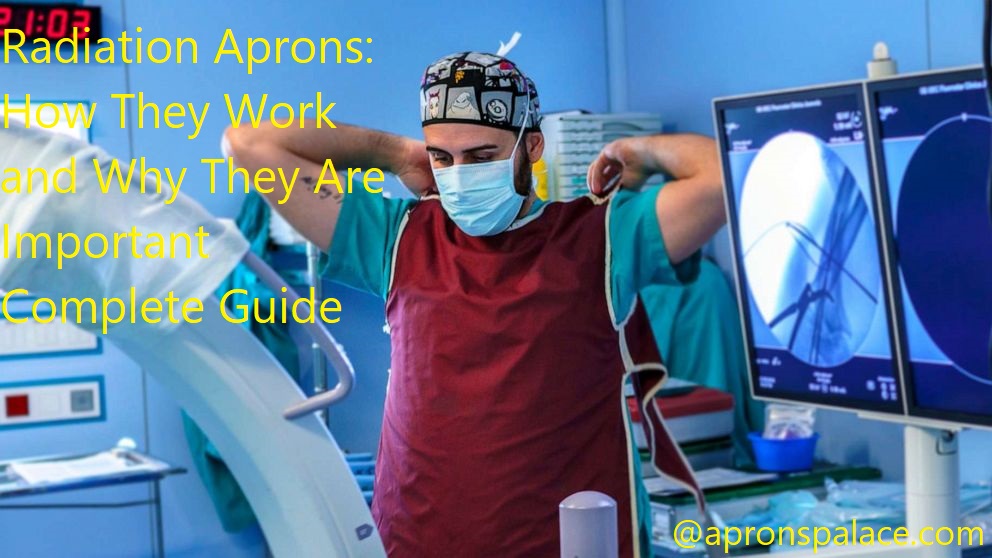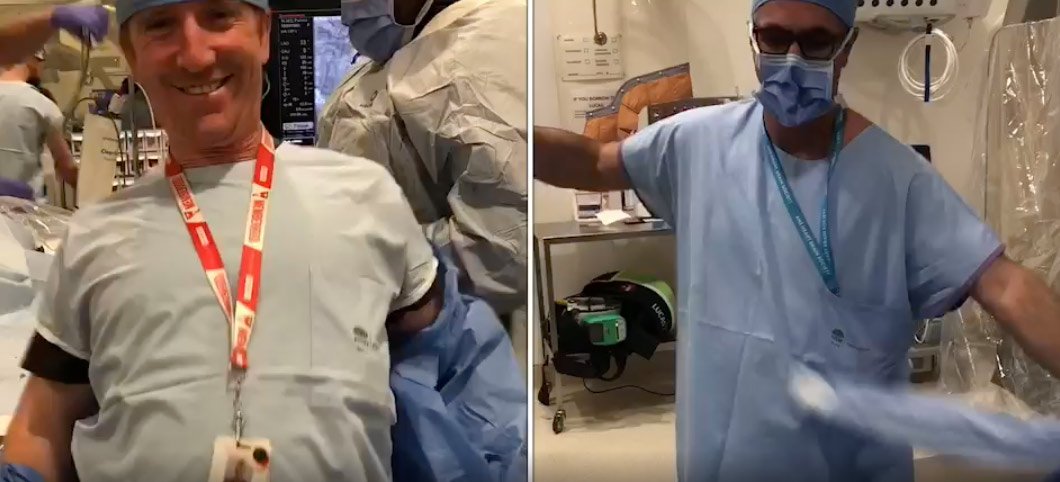Have you ever wondered how radiation aprons work to protect healthcare professionals from radiation exposure?
Understand the basics of radiation safety today and discover why radiation aprons are so important in the medical field. You need to be aware of the risks and know what needs to be done to ensure your safety.
Know more by reading this comprehensive guide on Radiation Aprons!
Radiation aprons are commonly used in medical imaging tests such as X-ray, MRI and CT scans. They are designed to provide a protective barrier between patients and radiation. Radiation aprons help protect patients from the harmful effects of radiation exposure while maximizing the effectiveness of medical imaging results.
It is important to understand how radiation aprons work and why they are necessary in order to make an informed decision when considering diagnostic imaging exams. This guide will provide an overview of radiation apron basics, including various types, design features, protection levels and the importance of proper use. Additionally, it will discuss how to choose the right apron for your needs, as well as additional safety measures that may be necessary during certain exams.
Explanation of radiation aprons
Radiation aprons, also known as radiation protection aprons, are protective medical garments used to reduce the risk of exposure to high-energy radiation. They are most commonly used during X-ray procedures and CT scans to shield specific parts of a body from radiation.
Radiation aprons are made of lead or other armor-like material and come in several different shapes and sizes. They typically fit over the back, abdomen, chest, neck and arms of a patient or medical professional, providing additional protection against harmful radiation.
Radiation aprons come in two forms: disposable or reusable. Disposable aprons should be discarded after use and are designed for single-use applications only; reusable aprons can be used multiple times for long-term protection and may have adjustable straps for different body types. Both types feature lead shielding that provides an extra layer of safety when working with nuclear medicine equipment.
Depending on their composition and thickness, these aprons can provide between 0.25mm/3mm/6mm worth of shielding from dangerous radiations emitted from diagnostic machines such as X-rays or CT scanners. In addition to absorption, some models also add reflection layers which work by bouncing off radiation back towards the source rather than allowing it to pass through the patient’s body tissues.

Importance of radiation aprons
Radiation aprons are integral for medical professionals and patients alike in reducing the incidents of radiation exposure. Radiation is a form of energy that has both natural and man-made sources, with the latter being more common in medical applications. In some cases, long-term exposure to radiation can lead to serious health issues including cancer, development of thyroid nodules, and dilated cardiomyopathy. This is why it is vitally important to ensure that adequate protective equipment is used when working with radiation in order to avoid any overexposure.
These protective garments come in a variety of styles and provide essential shielding from gamma rays, X-rays, electrons and other forms of radiation by absorbing most forms rather than reflecting them away. Radiation aprons have been designed using cutting edge materials such as lead cloth which offers maximum protection while being lightweight and flexible enough for extended periods of wear without fatigue or irritation. The amount of protection provided will depend on the strength of the material chosen but safely shields users from 33% – 50%.
The importance of using appropriate protective clothing such as radiation aprons cannot be underestimated as they act as a barrier between vital organs such as the thyroid gland and heart, protecting them from any high level exposures which could cause serious injury or death in worst case scenarios. It is important to be vigilant when handling radioactive materials and ensure you are wearing the highest quality protection available for your particular job title or work environment.
Radiation Basics
Radiation, in its simplest form, is energy released by atoms. When atoms become unstable due to a loss of particles, they spontaneously reconfigure their structure by emitting energy in the form of electromagnetic waves or particles. This radiation can come from natural sources, such as the sun or earth, or from man-made sources.
There are two types of radiation normally encountered when using and working with x-ray machines: ionizing and non-ionizing. Ionizing radiation has enough energy to remove electrons from atoms in living tissue cells which potentially leads to DNA damage and cellular mutations, which can cause cancer. Non-ionizing radiation does not have enough energy to directly cause DNA damage but can still cause other health problems such as tissue burns or fatigue.
It is important to note that while all ionizing radiation has the potential to be harmful to humans if overexposed, some forms are more hazardous than others based on their biological effects – alpha particles travel only a short distance before stopping (usually a few centimeters), while gamma rays travel much farther and are more penetrating. X-rays fall within this category because they travel right through most objects (including humans!). Therefore it is critical that medical professionals take extra precautions when operating x-ray machines so they don’t needlessly expose themselves (or others nearby) to dangerous amounts of radiation – including wearing protective technology such as aprons with heavy layers of protective metals like lead lining them.
Definition of radiation
Radiation is energy that comes from a source, travels through an area, and is not visible to the naked eye. This energy can take many forms including visible light, X-rays, gamma rays, and infrared radiation. Radiation can be divided into two categories: ionizing radiation and non-ionizing radiation. Ionizing radiation has enough energy to cause changes in atoms by removing electrons or breaking down molecules; it has direct effects on cells and can cause injury or illness. Examples of ionizing radiation include X-rays, gamma rays, and alpha particles. Non-ionizing radiation does not have enough energy to cause the same level of mutation or injury; this includes infrared rays and microwaves.
Medical personnel are at risk for exposure to harmful levels of ionizing radiation during routine examinations such as CT scans and X-rays. To protect them as they work with patients who may be exposed to these types of tests, they need to wear protective garments like aprons that are designed to block some types of low energy x-rays (also known as soft x-rays). These aprons contain shields that absorb a certain percentage of the x-ray beam’s energy which reduces the exposure a person receives when working near higher doses of x-ray beams generated during CT scans or other procedures.
Types of radiation
When purchasing a radiation apron, it is important to understand the type of radiation it will protect against. Radiation comes in three main types—alpha particles, beta particles, and gamma rays—and each type requires different materials to block them effectively.
Alpha Particles – Alpha particles have the least penetrating power of all types of radiation. A piece of paper can stop them, which means that any lead or other material used in radiation apron construction should be more than enough for protection.
Beta Particles – Beta particles are more energetic than alpha particles and can penetrate through materials such as wood and plastic. This means that to provide proper protection from beta radiation an apron must be made from material that is able to absorb their energy, such as heavy rubber or Kevlar® composites.
Gamma Rays – Gamma rays have the highest penetrating power of all forms of radiation and require thicker lead shielding to block them effectively. This is why most radiologists use so-called “lead aprons” instead of lighter weight vests for maximum protection against gamma rays.
Radiation Aprons
Radiation aprons protect medical professionals from radiation exposure during medical imaging procedures such as X-rays, computed tomography (CT scans) and fluoroscopy. They are designed to absorb the amount of radiation that might otherwise be absorbed by the body’s organs and tissues.
The most commonly used type of radiation apron is called the lead apron, which is made of lead-lined cloth, vinyl or plastic with lead sewn inside. The apron works by absorbing both primary and scattered radiation.
The material used in a radiation apron varies depending on its function and purpose. Generally, lead has been found to be one of the best materials for shielding humans against X-rays and gamma rays due to its high atomic number, which means that it is able to absorb higher levels of energy before becoming damaged itself. Lead can also be easily molded into different shapes for specialized applications such as adding protection for specific parts of the body like the thyroid or feet during certain imaging procedures.
Other materials that may be used in radiation aprons include tungsten and bismuth, which offer similar degrees of protection but are less common due to their higher cost.
What are radiation aprons?
Radiation aprons are protective garments designed to shield the wearer from any direct exposure to ionizing radiation. They are constructed with heavy and dense fabrics such as lead, rubber or plastic and composite materials. Radiation aprons typically include adjustable straps that can be fitted around the chest and waist area for a snug and secure fit.
Radiation aprons are essential for those who work with X-ray machines and other sources of radiation, including medical personnel, radiographers and certain industrial technicians. These garments not only protect the wearer from direct radiation exposure, but they also shield those in the vicinity from any potential scatter radiation stemming from the individual wearing the apron.
The protection provided by radiation aprons depends on several factors such as thickness of material used, type of material used, distance from source of radiation in addition to brand design or tailor-made fits for enhanced personal protection needs. With proper selection and use, radiation aprons help reduce safety risk significantly for all users.
Types of radiation aprons
Radiation aprons come in a variety of styles. Some offer more protection than others, with different materials used depending on the application. Here’s a breakdown of the most common types of aprons:
- Lead Apron: The most common type of radiation apron, lead aprons are typically made from single or double layers of lead or other materials such as cotton and nylon. Lead aprons provide up to 0.5 mm Pb shielding against X-ray radiation, as indicated on their rating tag.
- Lead & Fabric Apron: These aprons are designed with lead-impregnated fabric that is reinforced with metal, plastic or composite material. Lead and fabric aprons provide up to 0.25 mm Pb shielding against X-ray radiation, making them ideal for light duties and regular use where lighter weight is more important than greater protection.
- Silver Apron: As its name implies, silver aprons are made entirely out of silver-based material that provides effective X-ray blocking properties (up to 0.3 mm Pb) but does not last as long as traditional lead or lead/cloth aprons do. In addition to providing superior protection against gamma radiation, silver aprons weigh much less than conventional lead or cloth options and can be conveniently folded away when not in use for improved storage space economy.
- Heavy Duty Radiation Apron: As its name implies, heavy duty radiation protection is ideal for those needing superior shielding levels (up to 1 mm Pb) in high risk scenarios such as medical procedures involving chest X-rays and fluoroscopy applications using cesium–137 sources. Heavy duty models can also be constructed using aluminum sheeting which produces greater contrast obscuration compared to heavier traditional material alternatives while still providing the same level of protection needed in those situations involving higher levels of absorption dose rates (DPL).
How radiation aprons work
Radiation aprons are made with a lead core (usually 0.25- or 0.35-millimeter thick lead). This core is then encased in a lightweight but durable fabric, such as canvas or denim. The apron must be long enough and wide enough to cover the front of the wearer’s body, from their neck down to their lower torso, including their sides and arms.
When radiation is emitted from a machine like an X-ray generator or linear accelerator, it travels outward in all directions — including forward and backward through the air. When radiation aprons are worn by medical personnel during procedures, they act as a barrier between the emitted radiation and other parts of the body that should not be exposed to it.
The lead core of the apron absorbs most of the incoming radiation before it can pass through and harm any person directly exposed to it. Depending on how much time you spend around radiation sources, more than one layer of shielding may need to be worn for maximum protection — so make sure your hospital has several levels of specialty aprons available for staff use!
Maintaining Radiation Aprons
Radiation aprons, also known as protective clothing, should be checked periodically for any signs of damage or wear – including cuts, rips, fraying, broken straps and fading. It’s important to clean the apron after each use to remove any radiation contamination and prevent the spread of germs. Aprons should be gently washed in cold water with a mild detergent; never use chlorine-based bleach or ammonia-based products. Allow the aprons to air dry away from direct sunlight or strong air currents.
Additionally, protective lead shielding may need to be replaced if it becomes worn or damaged. Lead shields can lose protection over time due to age and wear and tear; it’s important that these are inspected regularly to ensure they are providing adequate protection against radiation exposure. Replace any shielded lining that has been damaged or shows significant signs of wear with appropriate lead shielding material; some manufacturers offer replacement linings made from lighter-weight materials such as nylon or neoprene as alternatives.
Cleaning and disinfecting radiation aprons
It is vitally important to properly clean and disinfect radiation aprons, as they absorb radiation during imaging procedures and can serve as a vector for the spread of germs and infection. To ensure safety, it is essential to follow the guidelines outlined by the American Association of Radiologic Technologists when cleaning and disinfecting radiation aprons.
Before cleaning an apron, it is important to make sure that any visible dirt or debris has been removed. This can be done using a damp cloth, taking care that all surfaces of the apron have been wiped down. Once this is done, it is safe to wash the apron in hot water (at least 180°F) with soap or detergent. All soiled areas should be washed separately from those which remain clean. After cleaning, aprons must be dried using paper towels or warm air dryers; aprons must not be hung up until completely dry in order to prevent bacterial contamination from dampness.
Finally, after an apron has been washed and dried, it must then be disinfected using approved decontamination products recommended by the American Association of Radiologic Technologists (AART). Approved products typically include Quaternary Ammonium Compounds (QUATs), peroxygen compounds or bleach-based solutions; refer to your facility’s local regulatory agency for specific recommendations in your area. Whatever product you choose should be diluted according to instructions on its packaging and left on affected items for at least 10 minutes in order to thoroughly kill bacteria, fungi and viruses which may have accumulated on the fabric’s surface during imaging procedures.
Finally, radiation aprons should also be inspected routinely; any damage or wear-and-tear found should lead to its immediate replacement due improper protection from potentially dangerous levels of radiation exposure.
Inspecting radiation aprons
It is important to periodically inspect radiation aprons for any damage that may have occurred during use. By checking for holes, cuts and tears in the material, clinicians can ensure that their patients and themselves are properly protected when using X-ray equipment.
Be sure to check the protective features of regulated radiation aprons before each use. Aprons must be inspected over the entire surface area, paying particular attention to any seams or edges that may bear evidence of deterioration or cracking. If an apron appears damaged or faded, it should not be used until it can be repaired or replaced. All defects in the apron should be marked with a felt-tip pen so they are easily identifiable and easily monitored.
In addition to inspecting a radiation apron for signs of wear and tear, it is important to also inspect other safety features such as buckles, straps and buttons. It is very important that these pieces remain secure to effectively create a barrier from potentially dangerous X-ray exposure. Check all connecting parts for any evidence of rusting or corrosion and verify that the straps secure into place without coming undone easily during treatment sessions. Radiation aprons must always be secure in order to effectively protect against potential dangers associated with X-ray machines.

Conclusion
Radiation aprons are essential pieces of protective gear for those working in radiology and other areas of healthcare. Properly designed and maintained radiation aprons are effective at protecting individuals from unnecessary exposure to radiation. Appropriate selection, use, and maintenance of radiation aprons will help ensure safety for healthcare professionals and patients, alike.
The proper size, type, and thickness of the apron should be chosen based on evaluating potential risks of exposure to radiation. Maintenance includes inspection before use, washing, periodic hydro-testing (for lead Aprons), replacing after wear or tear is evident, or when your facility’s guidelines recommend so. The environment where the apron is used should also be inspected regularly to prevent the build-up of hazardous materials that can reduce the protection that the apron offers.
Additionally, equipment in use needs to be functioning correctly in order for it to emit proper levels of radiation during procedures; malfunctions may increase exposure beyond acceptable levels should they occur during treatment. Overall, proper care and thought must be taken when selecting an apron for protection against unwanted/unnecessary exposure.
FAQ’s
What is radiation protection and why it is important?
Radiation protection refers to measures taken to limit exposure to ionizing radiation. It is important because exposure to ionizing radiation can be harmful to human health and can increase the risk of cancer and other diseases.
What is the importance of lead apron?
A lead apron is important because it provides a barrier between the body and ionizing radiation, reducing the amount of radiation exposure to the wearer.
How does a lead apron work?
A lead apron works by blocking ionizing radiation from passing through the material of the apron. The lead atoms in the apron absorb the radiation, preventing it from reaching the body of the wearer.
What are the different types of lead aprons?
The different types of lead aprons include standard lead aprons, lightweight lead aprons, and wrap-around lead aprons. There are also variations in the amount of lead protection and the size of the apron.
What is the classification of apron?
Lead aprons are classified according to the amount of lead protection they provide, with higher lead equivalence ratings indicating greater protection.
How are lead aprons stored?
Lead aprons should be stored in a dry, cool place, away from direct sunlight and heat sources. They should be hung on a specialized hanger to avoid folds or creases in the lead.
How do you test lead aprons?
Lead aprons can be tested using a variety of methods, including fluoroscopy, dosimeters, or a visual inspection for signs of wear and tear.
What is the minimum lead apron?
There is no set minimum requirement for lead aprons, but they should have a lead equivalence rating that is appropriate for the level of radiation exposure in the workplace.
How do lead free aprons work?
Lead-free aprons use alternative materials, such as bismuth, to provide radiation protection. These materials have similar properties to lead in terms of radiation absorption.
How do I choose an apron?
When choosing an apron, factors to consider include the level of radiation exposure in the workplace, the size and weight of the apron, and the amount of lead protection provided by the apron. A qualified radiation protection specialist can provide guidance on selecting an appropriate apron.
See more-
- Best aprons for chefs 2023
- Best aprons for men 2023
- Best workshop aprons 2023
- Best work aprons 2023
- Best woodworking aprons 2023

Douglas Keefer is the CEO and author of apronspalace.com and Informative Website. With his extensive knowledge and expertise in the world of aprons, he has helped thousands of people find the perfect apron for their needs. Douglas’s commitment to transparency and honesty has made apronspalace.com stand out in a sea of biased reviews and sponsored content. He is a true pioneer in the world of aprons and a passionate advocate for the culinary arts


